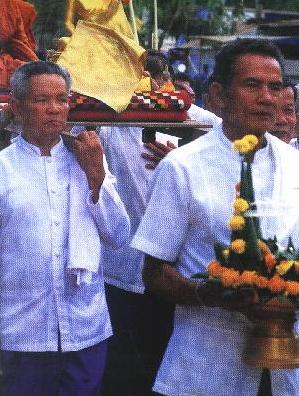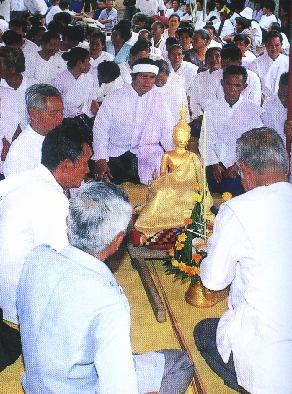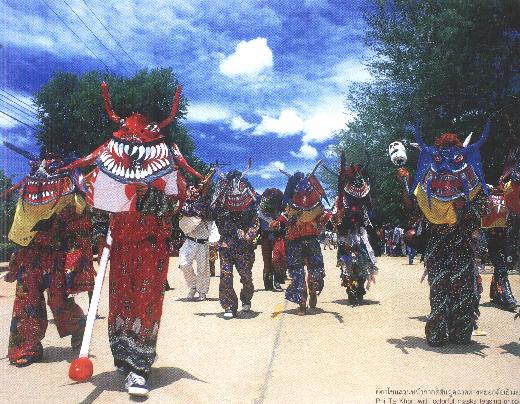|
|
|
||
|
After reading the content, do you agree with the information presented
on this page? Please Click a Vote at POLLBAGEL
Do you agree that there are conflicting information on Legends and Historical documents between the Tipitaka and those in Ancient India?
Overall, are you convinced that Lord Buddha and his monks lived in the land comprising Thailand, Laos, Kampuchea, Mianmar, and Raman?
Webmaster:
chaiyongusc@gmail.com
|
ARIYA SASTRA SHOWING LEGENDARY RECORDS IN THAILAND AS APPEARING IN THE BUDDHIST TIPITAKA It's a pity that traditional legends were not accepted as historical evidences by Western historians. Yet one cannot deny that legends are based on the so-called "oral-tradition" carrying over the stories of their ancestors in the old past to be learned by the present generations. Ariyasastra is the true status of seeing and knowing all without being lured to illusion and untimately bring an indivual up to the outerspace of the Universe called Nippana through the holy, timeless (Akaligo) and spaceless (Atesigo) energy called Bunya. Sad to say, the whole world is now influencetod by the socalled "science" emphasizing reality based on observations by five senses: eyes, ears, nose, tongue and physical touches. Scientists denied anything beyond these five senses as superstitous. In reality, the world had been influence by Ariyaststra, where perception via seven senses were accepted with addition of the Mind and the Soul enabling human beings to seeing all and knowing all ; thus, breaking through the dimensions of space and time. Legends generally conveyed extra-phenomena or super abilities such as elevation, invisibility, and ability to perform "Ajintaya" - certain actions beyond perception of ordinary human ability in similar belief as the Christians belief in the act of God. They were considered by Western academicians as supernatural, as the means to help people behave themselves. However, the essence of the stories remain in tact concrete enough for interested people to trace back the truth. In the Northern and Northeastern parts of Thailand, there are hundred stories inscripted in the Bai Larn (a type of palm leaves) telling about the stories of chedis, stupas, and other types of Buddhist sites and artifact unprovable by scientific approaches. In the North, most historical documents recorded the presence of the Buddha when He visited places along with his disciples such as Ananda, Saributra (different person from the Sariputasa found at Sanchi by Sir Alexander Cunningham), and King Asoka (different one from King Sri Thamma Asokaraj). The Buddha would kindly give a piece or two of his hair to be worshipped by the native people. They would soon build a chedi or stupa to keep the hair for future reverence. The Buddha would also give prediction on the future of the place as to what city it would be named and ruled by whom. The native people would keep the records both in oral tradition and in their native writing system in Pali or the indegenous languages called "Aksara Dhamma" In the Northeast of Thailand, the Bai Larn inscriptions recorded Lord Buddha's teachings and stories of His presence relating to different places. Ancient names of cities, towns, and people, found in the Tipataka, are still found in many parts of Thailand such Sakate nagar (Roi-Ed), Kandhara (Kantaravichai), Sawathee (Sawathi in Konkhaen Province), Pawai (on the bank of Pawaya River in Roi-Ed) and Kapilapasdu (near Udorn Province.
|
Sadly, due to the belief that Buddha was born in India, all of these cities and town were believed to be imitation of the names of cities and towns in India. Kapilapasdu, home town of the Godama Buddha, was built a long time ago, beyond the perception of Western who believe that human race was exited a few million years. According to the Pra Prathom Sompothigatha ( Buddha's History), the town was built upon the advice of Kapila Rushi and named after him. Since the founding year, there were 84,000 kings before the named was changed to Bichai Chetudorn in the time of King Wessandorn and his wife, Queen Massi. After then, there were 163,000 kings before the name was returned to Kapilapastu at the time of King Chayasen, Great grand father of the Buddha. Two thousand years are gone and the name Pichai Chetudorn was shortened to "Udorn." Consequently, the Laotians and Isan people belief for so long that Wessandorn and his people were their ancestors and they conducted the greatest celebration of Boon Pawade as memorial to King Wessandorn who was born more than 18 million years ago. Another evidence to confirm that King Wessandorn (พระเวสสันดร) and Queen Massi (พระนางมัทรี) lived in the Northern Isan around Udorn and Loiey Province is the annual celebration of the time King Wessandorn, who exiled himself to live a hermit's life in the Himapan Forest, was invited by his parents, King Sanchai and Queen Pusadee, to rule the country again. Spirits or ghosts (Pee) of different forms who used to take care of them during their hermit hood followed them back to town..
The Hae Pee Ta Khone (แห่ผีตาโขน) celebration marking the day spirits followed King Wessandorn and Queen Massi back to Sipi City to rule the country again after King Wessandorn exiled himself and his family to live a hermit's life in the Himapan Jungle. (Photo courtesy of Thai International Airways's Kinaree Magazine (July 2003, page 41) |
|
After reviewing the presented information on this page, before leaving kindly cast a vote:
Webmaster: chaiyong@buddhabirthplace.com; chaiyongusc@gmail.com





